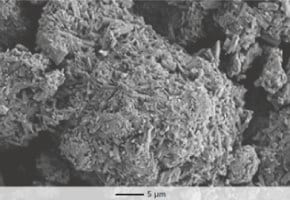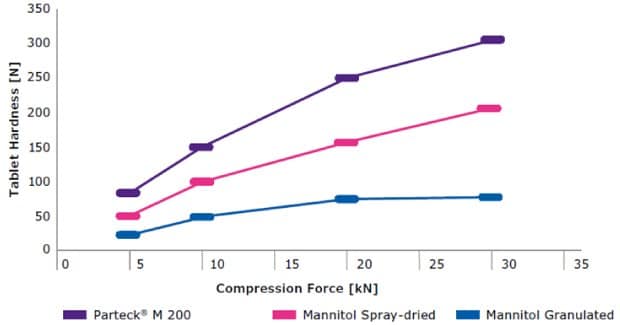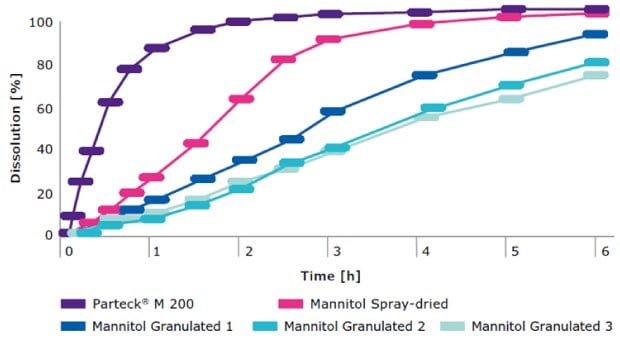Use of Mannitol as an Excipient for Solid Drug Formulation
Fillers in Solid Dose Formulation
Fillers add volume to the formulation while conferring mechanical properties that increase flowability and compressibility which facilitate manufacturing and increase the robustness and content uniformity of the final formulation.1 For decades, lactose, microcrystalline cellulose, and calcium hydrogen phosphate dihydrate have been used as fillers in solid dose formulations.
Read more about
- Advantages of Mannitol as a Filler In Solid Drug Formulation
- Use of Parteck® M Mannitol In Various Tableting Methods
- Versatility of Parteck® M Mannitol In Solid Dose Formulations
- Parteck® M Mannitol Excipient: A Broad Range of Applications
- Related Products
Advantages of Mannitol as a Filler in Solid Drug Formulation
Mannitol has become increasingly popular as a filler in common tablet manufacturing technologies including direct compression, roller compaction, and various wet granulation processes. It has advantageous physicochemical characteristics such as low hygroscopicity, inertness with respect to APIs, has no known adverse effects in humans, good compatibility, and the ability to produce extremely robust tablets. Because mannitol is of vegetable origin, there is no bovine or transmissible spongiform encephalopathy (BSE, TSE) risk or issues related to substances of genetically modified origins (GMO).
Mannitol is also well-suited for the formulation of orally disintegrating tablets, and with a very low water content (<0.3%) it is well-suited for formulation of moisture sensitive APIs.
Mannitol Polymorphic Forms and Grades
At least three different modifications of mannitol exist and are denoted as α, β and δ, with the β modification being the most stable. Mannitol is available in different grades including crystalline, crystallized, spray-dried, and granulated, with each having distinct properties. Studies have shown that spray-dried mannitols with high surface areas have beneficial properties for solid dose formulation. Learn more in the technical article about this topic.
Use of Parteck® M Mannitol in Various Tableting Methods
Direct Compression
Parteck® M mannitol excipient is mannitol in its most stable polymorphic form: 100% beta mannitol. It is a particle-engineered mannitol with excellent compressibility, making it highly suitable for direct compression. It yields robust and hard tablets with rapid disintegration and quick release of the API. In addition, it supports an efficient process and good final dosage performance regardless of whether it is a high or low dose formulation.
Dry Granulation and Roller Compaction
In cases where direct compression is not a suitable approach for tableting due to lack of homogeneity or separation of the formulation components, dry granulation can be added as a step prior to tableting. This step increases the bulk density of powders and improves flow properties and content uniformity. Dry granulation is suitable for thermally sensitive APIs and APIs that could undergo degradation in an aqueous environment. A common approach to dry granulation is roller compaction of the powder blend. Learn more in the technical article about this topic.
In roller compaction, directly compressible, spray-dried mannitols with a greater surface area produce stronger tablets than granulated or crystallized mannitol grades with smaller surface areas.
Wet Granulation
Wet granulation serves the same purpose as dry granulation – agglomeration of powder particles to improve homogeneity, flowability and compressibility of the tableting mixture as well as content uniformity of the final dosage form – but uses a solvent and typically a binder in the granulation process. Parteck® M mannitol is particularly well-suited for use in wet granulation processes and offers important benefits in final tablet quality (hardness, faster disintegration) compared with regular mannitol.
Versatility of Parteck® M Mannitol in Solid Dose Formulations
Not only is mannitol, and in particular Parteck® M mannitol excipient, recognized as an excellent filler excipient for a wide variety of APIs and solid dose formulations. It is extremely versatile for use in different tableting methods, it has the characteristics needed to address a wide variety of solid dose formulations.
Parteck® M mannitol is particle-engineered for best performance in the solid dose manufacturing and offers broad flexibility with regard to manufacturing, even for more challenging solid dose formulations such as low and high-dose and micronized APIs which are described below.
High Dose Formulations: Compressibility and Dilution Potential
With its open and filamentary particle structure (Figure 1), Parteck® M mannitol excipient enables tablets to be compacted at low compression forces (Figure 2), minimizing the wear and tear on equipment. Because it is free-flowing, it helps to maintain a stable and high-throughput process.

Figure 1.SEM showing highly structured surface area of Parteck® M mannitol excipient

Figure 2.Comparison of compression profiles of different commercially available mannitol grades for direct compression. Placebo formula using 1% magnesium stearate.
Some APIs do not lend themselves well to compression and in these cases, Parteck® M mannitol can be used as a diluent for tableting. Up to 60% of non-directly compressible actives can be included in the formulation, enabling a reduction in tablet sizes with high loads of APIs.
Low Dose Formulations: Uniform Doses with Homogenous Distribution
Parteck® M mannitol adsorbs API particles on its large surface area which can help to stabilize a formulation and prevent particle segregation during the tableting process. This is especially relevant for low-dose formulations, in which homogeneity of the blend and content uniformity of the final dosage forms are of primary importance.2
Micronized APIs: Improved Content Uniformity
Micronized APIs, with an extremely small particle size compared to the excipients in the formulation, can experience de-mixing during direct compression manufacturing leading to issues with content uniformity in the final dosage form.
Obtaining a homogenous mixture of the micronized API and excipients while maintaining product stability can be challenging. In addition, for micronized APIs used in the formulation of highly potent drugs that require low dosage, content uniformity is crucial and can be difficult to achieve.
It is possible to achieve a stable, uniform mixture of both micronized hydrophilic and hydrophobic API particles (< 15 μm) with Parteck® M mannitol excipient.2 The stability results from an adsorptive binding force strong enough to withstand mechanical separation forces.
Immediate Release Formulations: Rapid Disintegration and Dilution
With a unique particle structure and large surface area, Parteck® M mannitol enables even very hard tablets to both disintegrate and dissolve, faster and more easily (Figure 3).

Figure 3.Dissolution profiles comparing fenofibrate formulations based on different commercially available directly compressible mannitol grades. Formulas consisting of 20% (100 mg) micronized fenofibrate, 1% silicon dioxide, 1.5 % magnesium stearate, and 77.5 % DC-mannitol, compressed into 500 mg tablets with a hardness of 80 ± 5 N.
Parteck® M Mannitol Excipient: A Broad Range of Applications
The specific particle properties of Parteck® M mannitol excipient, such as a large surface area and low hygroscopicity, make it well-suited for all common tablet manufacturing processes. It offers a number of benefits for the formulation of a range of APIs including:
- High compressibility and dilution potential
- Content uniformity
- Rapid disintegration and dissolution
- Low level of impurities and water content making it compatible with all APIs
- Plant origin and GMO-free
- Non-hygroscopic
- Stable in polymorphic form
Learn more about formulation development and guidelines for these manufacturing processes and suitable excipients in our Formulation Handbook.
Related Products
References
如要继续阅读,请登录或创建帐户。
暂无帐户?